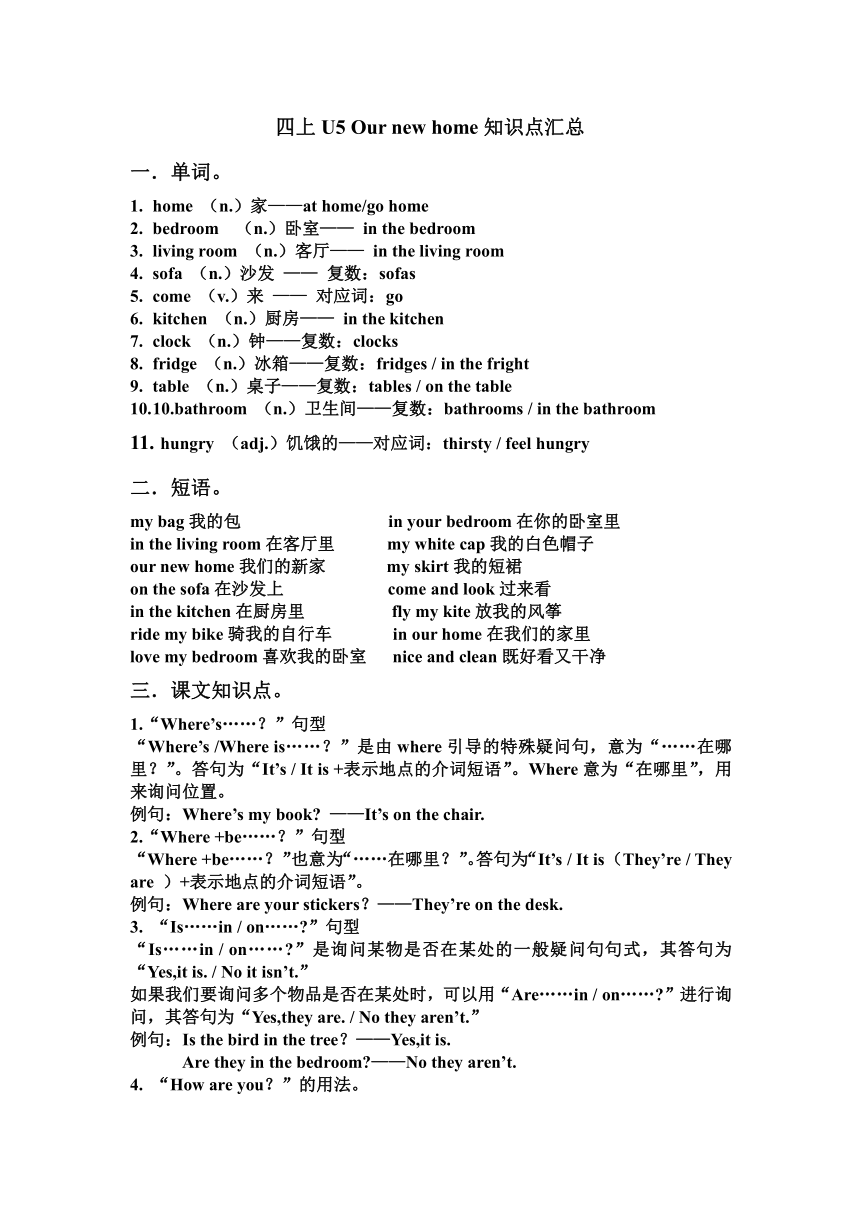牛津译林版英语四年级上册Unit 5-6知识点汇总(知识清单)
文档属性
| 名称 | 牛津译林版英语四年级上册Unit 5-6知识点汇总(知识清单) |  | |
| 格式 | docx | ||
| 文件大小 | 26.3KB | ||
| 资源类型 | 教案 | ||
| 版本资源 | 牛津译林版 | ||
| 科目 | 英语 | ||
| 更新时间 | 2024-02-03 09:44:34 | ||
图片预览

文档简介
四上U5 Our new home知识点汇总
单词。
home (n.)家——at home/go home
bedroom (n.)卧室—— in the bedroom
living room (n.)客厅—— in the living room
sofa (n.)沙发 —— 复数:sofas
come (v.)来 —— 对应词:go
kitchen (n.)厨房—— in the kitchen
clock (n.)钟——复数:clocks
fridge (n.)冰箱——复数:fridges / in the fright
table (n.)桌子——复数:tables / on the table
10.bathroom (n.)卫生间——复数:bathrooms / in the bathroom
hungry (adj.)饥饿的——对应词:thirsty / feel hungry
短语。
my bag我的包 in your bedroom在你的卧室里
in the living room在客厅里 my white cap我的白色帽子
our new home我们的新家 my skirt我的短裙
on the sofa在沙发上 come and look过来看
in the kitchen在厨房里 fly my kite放我的风筝
ride my bike骑我的自行车 in our home在我们的家里
love my bedroom喜欢我的卧室 nice and clean既好看又干净
课文知识点。
1.“Where’s……?”句型
“Where’s /Where is……?”是由where引导的特殊疑问句,意为“……在哪里?”。答句为“It’s / It is +表示地点的介词短语”。Where意为“在哪里”,用来询问位置。
例句:Where’s my book ——It’s on the chair.
2.“Where +be……?”句型
“Where +be……?”也意为“……在哪里?”。答句为“It’s / It is (They’re / They are )+表示地点的介词短语”。
例句:Where are your stickers?——They’re on the desk.
“Is……in / on…… ”句型
“Is……in / on…… ”是询问某物是否在某处的一般疑问句句式,其答句为“Yes,it is. / No it isn’t.”
如果我们要询问多个物品是否在某处时,可以用“Are……in / on…… ”进行询问,其答句为“Yes,they are. / No they aren’t.”
例句:Is the bird in the tree?——Yes,it is.
Are they in the bedroom ——No they aren’t.
“How are you?”的用法。
“How are you?”意为“你好吗?”。它的用法如下:
用来询问身体状况。
用来寒暄
例句:How are you?——Fine,thank you./Not so good.
“Would you like…… ”句型
“Would you like…… ”是征求对方意见的一种常用句型,是一种委婉的表达方式,意为“你愿意……吗?/你想要……吗?”。
其肯定回答为:“Yes,please.”;否定回答为“No,thank you/thanks.”
四上U6 At the snack bar知识点汇总
单词。
at(介词)在某处——at home在家 / at school在学校
注:at表示在某处或在某个时间。
snack bar快餐店,小吃店——at a snack bar在一家快餐店
hamburger(n.) 汉堡包——复数:hamburgers
a glass of一杯
注:a glass of指的是“一(玻璃)杯”。glass的复数是在词尾加-es。如果要表达的数量不止一杯,则用“大于一的数词+glasses of”形式。
noodles(n.)面条—— a bow of noodles一碗面条
dad(n.) 爸爸——同义词:father
注:dad用于口语中,是较亲昵的称呼,在正式场合和书面语中一般用father。另外,当dad和father单独用作称呼语时,其首字母要大写。
sandwich(n.) 三明治——复数:sandwiches
a cup of一杯
注:cup一般指带有手把的瓷杯,而glass一般指没有手把的玻璃杯。
coffee(n.) 咖啡——液体,为不可数名词 drink coffee喝咖啡
tea(n.) 茶——液体,为不可数名词 drink tea喝茶
juice(n.) 果汁——液体,为不可数名词 a glass of juice一杯果汁
rice(n.) 米饭;大米——不可数名词
fish(n.) 鱼——复数:fishes
注:作“鱼肉”讲时,是不可数名词。
14.big(adj.) 大的——同义词:large
二.短语。
a cup of coffee一杯咖啡 a cup of tea一杯茶
a glass of juice一杯果汁 some fish一些鱼
a big egg一个大鸡蛋 some rice一些米饭
at the snack bar在快餐店 would like想要
a glass of milk一杯牛奶 some noodles一些面条
see the box看见那个盒子
三.课文知识点。
1.“What would you like ”的用法
此句用来询问对方想要什么物品。当对方到你家做客时,你也可以用“What would you like ”来询问对方想吃什么或想喝什么。Would like的同义词是want,此句也可以表述为“What do you want ”
例句:What would you like ——I’d like a cup of tea and some rice.
“I’d like……”句型
“I’d like……”意为“我想要……”,后接想要的物品。
“Anything else ”的用法
此句是用来询问别人是否还需要其它东西的一种简略用语。其答句为“Yes,I’d like……”或“No,thanks.”
4.常用的食品,饮料类不可数名词
water 水 tea 茶 juice 果汁 coffee咖啡
bread面包 rice 大米 chicken 鸡肉 beef牛肉
chocolate巧克力 meat肉
拓展:在英语中,表示不可数名词的量通常用“基数词/a/an+单位词+of+不可数名词”结构。如:a glass of juice一杯果汁; two cups of tea两杯茶
a cup/glass of一杯 a pair of一双(副) a bow of一碗
a bag of一包 a bottle of一瓶 a carton of一盒
a box of一箱 a bar of一条
5.“Me too.”的用法。
口语中的“Me too.”用于表示自己的情况与前面提到的一样,意为“我也是。”,相当于“I……too.”。
例句:I like hamburger.——Me too.
6.“Here’s……”句型
意为“这儿有……”,后接可数名词单数或不可数名词,Here’s=Here is;如果要接复数名词,则用“Here are……”。
例句:Here’s a cake.
fish的用法
用作可数名词表示“鱼的条数”时,单复数形式相同,都是fish,如two fish;
用作可数名词表示“鱼的种类”时,复数形式为fishes,如two kinds of fishes;
用作不可数名词时,无复数形式,意为“鱼肉”。
“Can I help you ”的用法
此句是营业员询问顾客时的常用语,表示“你们想要买什么东西吗?”相当于“what would you like?”;也可用在对方遇到困难时,此时意为“需要我帮忙吗?”。
例句:Can I help you ——A cup of tea and two eggs,please.
“What a/an……!”句型
“What (a/an)+形容词+名词(+主语+谓语)!”是感叹句的一种常用句式,用来表示对某人,某物或某事的感受。在英语中,感叹句一般由what或how引导,what修饰名词,how修饰形容词或副词。
例句:What a beautiful girl!
How beautiful the girl is!
单词。
home (n.)家——at home/go home
bedroom (n.)卧室—— in the bedroom
living room (n.)客厅—— in the living room
sofa (n.)沙发 —— 复数:sofas
come (v.)来 —— 对应词:go
kitchen (n.)厨房—— in the kitchen
clock (n.)钟——复数:clocks
fridge (n.)冰箱——复数:fridges / in the fright
table (n.)桌子——复数:tables / on the table
10.bathroom (n.)卫生间——复数:bathrooms / in the bathroom
hungry (adj.)饥饿的——对应词:thirsty / feel hungry
短语。
my bag我的包 in your bedroom在你的卧室里
in the living room在客厅里 my white cap我的白色帽子
our new home我们的新家 my skirt我的短裙
on the sofa在沙发上 come and look过来看
in the kitchen在厨房里 fly my kite放我的风筝
ride my bike骑我的自行车 in our home在我们的家里
love my bedroom喜欢我的卧室 nice and clean既好看又干净
课文知识点。
1.“Where’s……?”句型
“Where’s /Where is……?”是由where引导的特殊疑问句,意为“……在哪里?”。答句为“It’s / It is +表示地点的介词短语”。Where意为“在哪里”,用来询问位置。
例句:Where’s my book ——It’s on the chair.
2.“Where +be……?”句型
“Where +be……?”也意为“……在哪里?”。答句为“It’s / It is (They’re / They are )+表示地点的介词短语”。
例句:Where are your stickers?——They’re on the desk.
“Is……in / on…… ”句型
“Is……in / on…… ”是询问某物是否在某处的一般疑问句句式,其答句为“Yes,it is. / No it isn’t.”
如果我们要询问多个物品是否在某处时,可以用“Are……in / on…… ”进行询问,其答句为“Yes,they are. / No they aren’t.”
例句:Is the bird in the tree?——Yes,it is.
Are they in the bedroom ——No they aren’t.
“How are you?”的用法。
“How are you?”意为“你好吗?”。它的用法如下:
用来询问身体状况。
用来寒暄
例句:How are you?——Fine,thank you./Not so good.
“Would you like…… ”句型
“Would you like…… ”是征求对方意见的一种常用句型,是一种委婉的表达方式,意为“你愿意……吗?/你想要……吗?”。
其肯定回答为:“Yes,please.”;否定回答为“No,thank you/thanks.”
四上U6 At the snack bar知识点汇总
单词。
at(介词)在某处——at home在家 / at school在学校
注:at表示在某处或在某个时间。
snack bar快餐店,小吃店——at a snack bar在一家快餐店
hamburger(n.) 汉堡包——复数:hamburgers
a glass of一杯
注:a glass of指的是“一(玻璃)杯”。glass的复数是在词尾加-es。如果要表达的数量不止一杯,则用“大于一的数词+glasses of”形式。
noodles(n.)面条—— a bow of noodles一碗面条
dad(n.) 爸爸——同义词:father
注:dad用于口语中,是较亲昵的称呼,在正式场合和书面语中一般用father。另外,当dad和father单独用作称呼语时,其首字母要大写。
sandwich(n.) 三明治——复数:sandwiches
a cup of一杯
注:cup一般指带有手把的瓷杯,而glass一般指没有手把的玻璃杯。
coffee(n.) 咖啡——液体,为不可数名词 drink coffee喝咖啡
tea(n.) 茶——液体,为不可数名词 drink tea喝茶
juice(n.) 果汁——液体,为不可数名词 a glass of juice一杯果汁
rice(n.) 米饭;大米——不可数名词
fish(n.) 鱼——复数:fishes
注:作“鱼肉”讲时,是不可数名词。
14.big(adj.) 大的——同义词:large
二.短语。
a cup of coffee一杯咖啡 a cup of tea一杯茶
a glass of juice一杯果汁 some fish一些鱼
a big egg一个大鸡蛋 some rice一些米饭
at the snack bar在快餐店 would like想要
a glass of milk一杯牛奶 some noodles一些面条
see the box看见那个盒子
三.课文知识点。
1.“What would you like ”的用法
此句用来询问对方想要什么物品。当对方到你家做客时,你也可以用“What would you like ”来询问对方想吃什么或想喝什么。Would like的同义词是want,此句也可以表述为“What do you want ”
例句:What would you like ——I’d like a cup of tea and some rice.
“I’d like……”句型
“I’d like……”意为“我想要……”,后接想要的物品。
“Anything else ”的用法
此句是用来询问别人是否还需要其它东西的一种简略用语。其答句为“Yes,I’d like……”或“No,thanks.”
4.常用的食品,饮料类不可数名词
water 水 tea 茶 juice 果汁 coffee咖啡
bread面包 rice 大米 chicken 鸡肉 beef牛肉
chocolate巧克力 meat肉
拓展:在英语中,表示不可数名词的量通常用“基数词/a/an+单位词+of+不可数名词”结构。如:a glass of juice一杯果汁; two cups of tea两杯茶
a cup/glass of一杯 a pair of一双(副) a bow of一碗
a bag of一包 a bottle of一瓶 a carton of一盒
a box of一箱 a bar of一条
5.“Me too.”的用法。
口语中的“Me too.”用于表示自己的情况与前面提到的一样,意为“我也是。”,相当于“I……too.”。
例句:I like hamburger.——Me too.
6.“Here’s……”句型
意为“这儿有……”,后接可数名词单数或不可数名词,Here’s=Here is;如果要接复数名词,则用“Here are……”。
例句:Here’s a cake.
fish的用法
用作可数名词表示“鱼的条数”时,单复数形式相同,都是fish,如two fish;
用作可数名词表示“鱼的种类”时,复数形式为fishes,如two kinds of fishes;
用作不可数名词时,无复数形式,意为“鱼肉”。
“Can I help you ”的用法
此句是营业员询问顾客时的常用语,表示“你们想要买什么东西吗?”相当于“what would you like?”;也可用在对方遇到困难时,此时意为“需要我帮忙吗?”。
例句:Can I help you ——A cup of tea and two eggs,please.
“What a/an……!”句型
“What (a/an)+形容词+名词(+主语+谓语)!”是感叹句的一种常用句式,用来表示对某人,某物或某事的感受。在英语中,感叹句一般由what或how引导,what修饰名词,how修饰形容词或副词。
例句:What a beautiful girl!
How beautiful the girl is!
